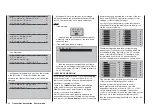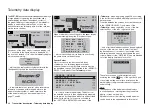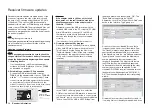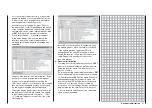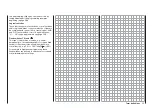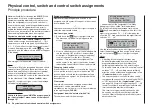
48
Receiver initialization
Charging the receiver battery
Charger cable, order no.
3021
, can be plugged
directly onto the receiver's battery for charging. If
the battery in the model is connected by way of
an order no.
3046
,
3934
,
3934.1
or
3934.3
power
supply cable, then charging can be accomplished
via the charging jack or special charging connector
integrated into the switch. The switch in the power
supply cable must be in its "OFF" position for
charging.
Receiver battery
connection polarity
Receiver system power supply
NiMH 4-cell battery packs
In compliance with the aforementioned conditions,
your
Graupner
HoTT receiver system can be readily
operated with traditional 4-cell battery packs as long as
the packs have adequate capacity and voltage level.
NiMH 5-cell battery packs
Five-cell battery packs offer a greater voltage
tolerance than do 4-cell packs.
However, be aware that not every servo available on
the market is able to tolerate the voltage level output
by a 5-cell pack over the long term, this is particularly
true when the battery pack is freshly charged. Some of
these servos react to this with a noticeable "grinding"
sound.
Therefore pay attention to the specifi cations of the
servos you use before making a choice for a 5-cell
battery pack..
LiFe 6.6 V batteries with 2 cells
From a contemporary perspective, these new cells
are the very best choice.
LiFe cells are also available in hard plastic casings
to protect them from mechanical damage. Like LiPo
cells, LiFe cells can be quick charged in suitable
chargers and they are comparatively robust.
This type of secondary cell battery is also rated for
a signifi cantly greater number of charge/discharge
cycles than, for example, LiPo batteries The nominal
6.6 V output of a 2-cell LiFe battery pack does
not present a problem for either
Graupner
HoTT
receivers nor for those servos, speed controllers,
gyros and other devices which have been specifi cally
approved for operation in this – higher – voltage range.
Please note however that practically all servos,
speed controllers, gyros and other devices built
in the past and most such devices currently still
offered on the market have only a permissible
voltage range of 4.8 to 6 V.
Use of these batteries
in conjunction with these devices demand use of
a stabilized voltage regulator, e.g. the PRX, Order
No.
4136
, see appendix. Otherwise there is danger
that attached devices will incur damage within a short
period of time.
LiPo 2-cell packs
For a given capacity, LiPo batteries are lighter than,
for example, NiMH batteries. LiPo batteries are also
available in hard plastic casings to protect them from
mechanical damage.
The comparatively high nominal voltage, 7.4 V, for
a 2-cell LiPo pack does not present a problem for
either
Graupner
HoTT receivers nor for those servos,
speed controllers, gyros and other devices which
have been specifi cally approved for operation in
this – higher – voltage range.
Please note however
that practically all servos, speed controllers,
gyros and other devices built in the past and
most such devices currently still offered on the
market have only a permissible voltage range
of 4.8 to 6 V.
Use of these batteries in conjunction
with these devices demand use of a stabilized
voltage regulator, e.g. the PRX, Order No.
4136
, see
appendix. Otherwise there is danger that attached
devices will incur damage within a short period of
time.
Summary of Contents for 32032
Page 1: ...33020 mc 20HoTT 2 en Programming Manual o Pro Pro mc 20 mc 20...
Page 15: ...15 For your notes...
Page 21: ......
Page 27: ...27 For your notes...
Page 41: ...41 For your notes...
Page 53: ...53 For your notes...
Page 59: ...59 For your notes...
Page 63: ...63 For your notes...
Page 93: ...93 For your notes...
Page 97: ...97 For your notes...
Page 141: ...141 How is a ight phase programmed...
Page 145: ...145 For your notes...
Page 155: ...155 For your notes...
Page 175: ...175 For your notes...
Page 203: ...203 For your notes...
Page 219: ...219 For your notes...
Page 253: ...253 For your notes...
Page 283: ...283 For your notes...
Page 321: ...321 For your notes...
Page 322: ...322 For your notes...
Page 323: ...323 For your notes...

